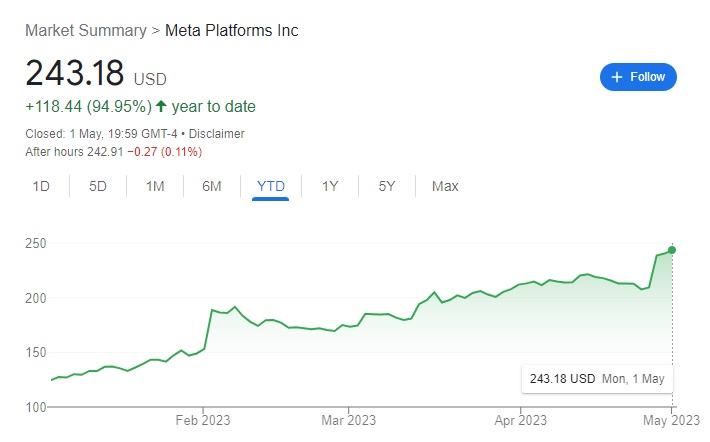Job cuts at Meta are proving successful for shareholders, with Meta’s share price having doubled since the start of the year.
Mark Zuckerberg, who owns 13.4% of the company, is one of the major beneficiaries of this policy. Thanks to the rising stock price, the entrepreneur’s personal wealth has grown by $42.3 billion since January.
Good news days
Things are beginning to look up for Mark. In recent months, the CEO has taken a prolonged pummeling from the press and industry analysts. Now it appears that he may have weathered the worst of the storm.
In part, that is thanks to two large rounds of job cuts. The first came in November with 11,000 workers axed. A further 10,000 jobs were chopped in March, resulting in 21,000 cuts within just six months. The aggressive cost-cutting exercise has been appreciated on Wall Street.
Last week, Meta announced its first-quarter results. Sales in the first three months were up 3% to $28.6 billion, demonstrating a return to growth. Zuckerberg delivered his assessment in a statement to accompany the results.
“We had a good quarter and our community continues to grow,” said Zuckerberg.
“Our AI work is driving good results across our apps and business. We’re also becoming more efficient so we can build better products faster and put ourselves in a stronger position to deliver our long-term vision.”
The announcement immediately prompted Meta shares to rise from $209.40 on Wednesday 26, to $238.56 on Thursday 27.
Zuckerberg’s personal wealth is closely tied to the value of Meta shares. In 2022, his personal fortune decreased by $71 billion compared to 2021 as stock prices fell.
Now 21,000 staff have been cut from the books, the share price and Zuckerberg’s wealth are rising once more.
Number goes up
Meta’s share price has effectively doubled since the start of the year. On January 3, shares in Meta Platforms Inc were trading at $124.74. That share price has risen by 94.95% today, to reach $243.18.

The numbers suggest that Meta’s ‘year of efficiency’ is yielding positive results, at least for those holding its shares. For those now seeking gainful employment, that might offer little succor.
Jobs cuts and bonuses
Shareholders may be happy with the latest round of layoffs, but ordinary workers have less to be cheerful about.
Zuckerberg was grilled by angry workers just two weeks ago, many of whom are incensed that top executives continue to receive huge bonuses even as their colleagues find themselves jobless.
Meta CPO Christopher Cox collected a bonus of $940,214, while CFO Susan Li received $575,613. CTO Andrew Bosworth picked up $714,588 while COO Jason Olivan claimed $786,552.
The disparity between C-level executives and ordinary workers continues to irk. It is a trend that is unlikely to change, however.
Mark Zuckerberg is not the only executive within big tech who is doing well after culling his workforce. As MetaNews previously reported, Alphabet CEO Sundar Pichai earned $226 million last year before culling 12,000 from Google’s payroll.
At the time Pichai said: “The fact that these changes will impact the lives of Googlers weighs heavily on me, and I take full responsibility for the decisions that led us here.”
As heavily as it might weigh on Pichai, the message from Wall Street is clear: cutting jobs is a shortcut to share price increases, and with it, the growth of eye-watering CEO wealth.









 and then
and then